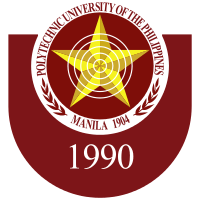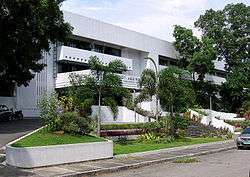Polytechnic University of the Philippines Open University
 | |
| Type | distance education |
|---|---|
| Established | 1990 |
| President | Emanuel C. De Guzman |
| Director | Anna Ruby Gapasin (executive) [1] |
| Location | Manila, Philippines |
| Campus | 9 physical and 1 virtual campuses |
| Colors |
Maroon and Gold |
| Affiliations | ICDE, AAOU, PSDL, APKBODL |
| Website |
www |
|
| |
The Polytechnic University of the Philippines Open University System is the nontraditional/distance studies unit of the Polytechnic University of the Philippines. It began with the offering of non-degree (technical-vocational) courses in 1970s and was formally established in 1990, making it the first open learning institution in the country. It is one of the only two open learning institutions in the Philippines recognized by the UNESCO Asia Pacific Knowledge Base on Open and Distance Learning. [2]
The PUP Open University was established to provide education opportunities to individuals aspiring for higher education and improved qualifications but were unable to take advantage of traditional modes of education because of personal and professional obligations. It is also known as the "Pamantasang Bayan," literally translating as "Nation's University" in Filipino.
Academics
Institutes and center
The PUP Open University consists of three units: Institute of Open and Distance Education/Transnational Education, Institute of Non-Traditional Studies Program and ETEEAP, and the Center of Professional and Continuing Studies, under which the Nontraditional Study Program and Expanded Tertiary Education Equivalency and Accreditation Program are under. The PUP Open University offers the following degree programs:
Institute of Open and Distance Education/Transnational Education
Bachelor's Programs
- Bachelor of Arts in Broadcast Communication
- Bachelor of Science in Entrepreneurship
Post-Baccalaureate Diploma Programs
- Post Baccalaureate Diploma in Information Technology
Master's Programs
- Master's in Communication
- Master's in Educational Management
- Master's in Public Administration
- Master of Science in Construction Management
- Master of Science in Information Technology [3]
Institute of Non-Traditional Studies and ETEEAP
Expanded Tertiary Education Equivalency and Accreditation Program (ETEEAP)
- Bachelor's in Advertising and Public Relations
- Bachelor's in Broadcast Communication
- Bachelor's in Cooperatives
- Bachelor's in Office Administration
- Bachelor's in Political Science major in International Relations
- Bachelor's in Public Administration and Governance
- Bachelor of Science in Business Administration Major in Marketing Management
- Bachelor of Science in Business Administration Major in Human Resource Development Management
- Bachelor of Science in Entrepreneurial Management
- Bachelor of Science in Information Technology
- Bachelor of Science in Sociology [4]
Non-Traditional Study Program (NTSP)
- Bachelor of Arts in English
- Bachelor of Arts in Filipinology
- Bachelor's in Advertising and Public Relations
- Bachelor's in Banking and Finance
- Bachelor's in Broadcast Communication
- Bachelor's in Cooperatives
- Bachelor's in Journalism
- Bachelor's in Office Administration
- Bachelor's in Public Administration and Governance
- Bachelor's in Political Science, Major in International Relations
- Bachelor of Science in Business Administration Major in Marketing Management
- Bachelor of Science in Business Administration Major in Human Resource Development Management
- Bachelor of Science in Computer Science
- Bachelor of Science in Economics
- Bachelor of Science in Entrepreneurial Management
- Bachelor of Science in Hotel and Restaurant Management
- Bachelor of Science in Industrial and Operational Psychology
- Bachelor of Science in Information Technology
- Bachelor of Science in Political Economy
- Bachelor of Science in Sociology
- Bachelor's in Tourism Management
- Master's in Communications
- Master of Public Administration
- Master of Business Administration [5]
Learning Centers

The PUP OU has 9 Learning Centers in strategic locations in the country. Most of the centers are mostly located in other PUP campuses in the selected regions of the country.
| Learning Center | Director | Campus location |
|---|---|---|
| Manila | Dr. Carmencita L. Castolo | Ninoy Aquino Library and Learning Resources Center, PUP Mabini Campus, Sta. Mesa, Manila |
| Quezon City | Dir. Pascualito B. Gatan | PUP Quezon City, Commonwealth, Quezon City |
| Lopez | Dir. Rufo Bueza | PUP Lopez, Lopez, Quezon |
| Maragondon | Dir. Denise A. Abril | PUP Maragondon, Maragondon, Cavite |
| Sablayan | Dir. Laurence P. Usona | PUP Sablayan, Sablayan, Occidental Mindoro |
| Sta. Rosa | Dir. Charito A. Montemayor | PUP Sta. Rosa, New Sta. Rosa Village, Congco Subd., Tagapo, Sta. Rosa, Laguna |
| Sto. Tomas | Dir. Frederick O. Ramos | PUP Sto. Tomas, Sto. Tomas, Batangas |
| Taguig | Dir. Sharon Joy F. Pelayo | PUP Taguig, Lower Bicutan, Taguig, Metro Manila |
| Unisan | Dir. Edwin G. Malabuyoc | PUP Unisan, Ibabang Ilaya, Unisan, Quezon |
In 2007, OU has launched the Open University Learning Management System (PUPOU-LMS or eMabini), where the faculty of the OU can hold classes online to Filipino students in United Arab Emirates, Hong Kong, Singapore, and Vietnam.[6]
References
- ↑ "PUP Open University". Polytechnic University of the Philippines. Retrieved July 2, 2016.
- ↑ "Asia Pacific Knowledge Base on Open and Distance Learning". Asia Pacific Knowledge Base on Open and Distance Learning. Retrieved April 13, 2015.
- ↑ "PUPOU Degree Programs". Polytechnic University of the Philippines. Retrieved April 13, 2015.
- ↑ "Expanded Tertiary Education Equivalency and Accreditation Program (ETEEAP)". Polytechnic University of the Philippines. Retrieved April 13, 2015.
- ↑ "Non-Traditional Study Program (NTSP)". Polytechnic University of the Philippines. Retrieved April 26, 2015.
- ↑ "PHL Ambassador Addresses Graduating Class of PUP- Open University in Abu Dhabi". Department of Foreign Affairs, Philippines. Retrieved April 13, 2015.
External links
- Polytechnic University of the Philippines Official website